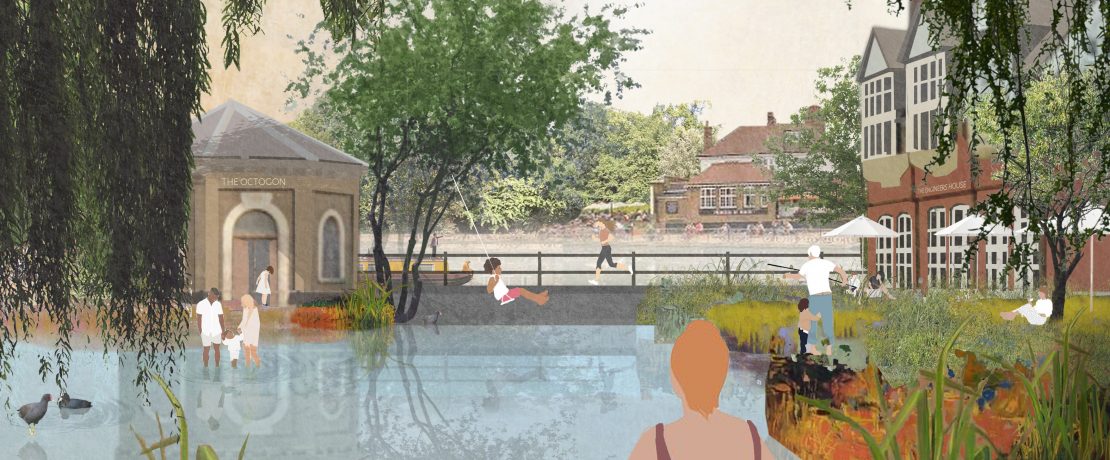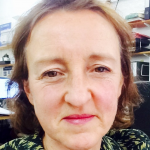Let’s create ten new parks for London!
London has just half the green space it needs for a population its size. And yet there are many green spaces in London which are just sitting idle – at best ignored, at worst deliberately run down by owners and coming under threat from development.
These are amazing green and protected sites which have been undervalued, simply left doing nothing – but which local communities want to bring back into use and turn into major new parks – and we want to help them do that.
- See the latest update for the local campaigns
What will we be doing? We are working with local groups to gain commitments from the Mayor of London and the relevant boroughs to work with local groups to transform these spaces into useful new parks. Some of these areas can become nature reserves; some can become improved sports facilities; some can be traditional parks. Some are so large they can be all of these.
What do we want the Mayor and London boroughs to do? We want the GLA and the relevant London boroughs to support the local campaigns and make a clear statement for each site that it will not be released for development; to promise to give each site a new identity as a park to be managed in conjunction with the local community; and to encourage landowners to bring down fences and reinstate public access.
How can you support the campaign?
- Tell us about any green site which is being neglected and could become a new park – and which you think could or should be brought into use, or back into use e.g. as a local park, nature reserve, playing field or for some other reason. This might be a site where public access has been lost in recent years. Email alice@cprelondon.org.uk and we can help you start a local campaign or support existing campaigns
- Support one of the local groups we’re working with by asking to join their mailing list. Find out more about the local campaigns we’re currently working with (see below) and email alice@cprelondon.org.uk and we can put you in touch
- Ask your council leader or Mayor to identify derelict and neglected green spaces, and any green spaces under threat, and actively work with the community to bring them back into use especially if they are at risk
- Write to the relevant local authorities, particularly if they live in the area local to one of the new parks, to ask them to support the local campaign
- Spread the word by sharing our posts on Twitter and Instagram @CPRELondon
The stories for each ‘new park’ site are very different. One of the sites we feature here – a huge set of community playing fields – was so run down the council nearly gave it away. Other sites we feature have been bought up by speculators, fenced off and allowed to become derelict in the hope that after time local residents will have forgotten about them and they will be able to gain planning permission to build on them. In many cases the owners or custodians have failed to manage the site effectively; or residents won’t even know it’s there because the community is effectively or physically excluded from the site. These kinds of sites are frequently subject to a cycle of decline: unused or under-used, unloved, under threat. At best these spaces are providing only a fraction of the benefits which they could provide were they to be given an identity as a local park and managed effectively. At worst they are already coming under threat from development – to be lost forever.
But the really amazing thing is that local community groups have come forward to transform these sites in new parks and nature reserves. Our Ten New Parks campaign launched in 2020 and we are in it for the long haul! We want to see all these sites turned into major new parks, creating essential new green spaces from London’s forgotten green assets.
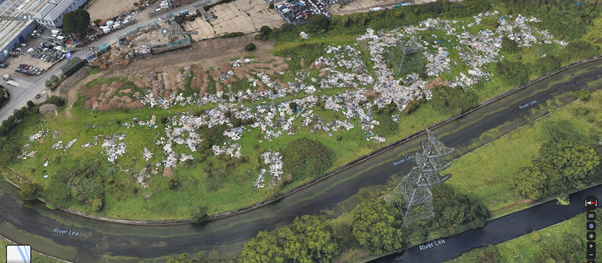
Watch this space over the coming months and years as we work with local groups to ensure Londoners get the full benefit of all our amazing green spaces.
So here’s the story so far: the first of our Ten New Parks for London (always space for more!)…
1. River Quaggy Trail and Sports Park
Sandwiched between a new housing development of several thousand new homes at Kidbrooke and a proposed new housing development in Lee Green district town centre, are various playing fields which also act as an important flood plain for the Quaggy River which runs through them. All the fields had protected Metropolitan Open Land (MOL) status until 2000, when they were all thriving as sports fields.
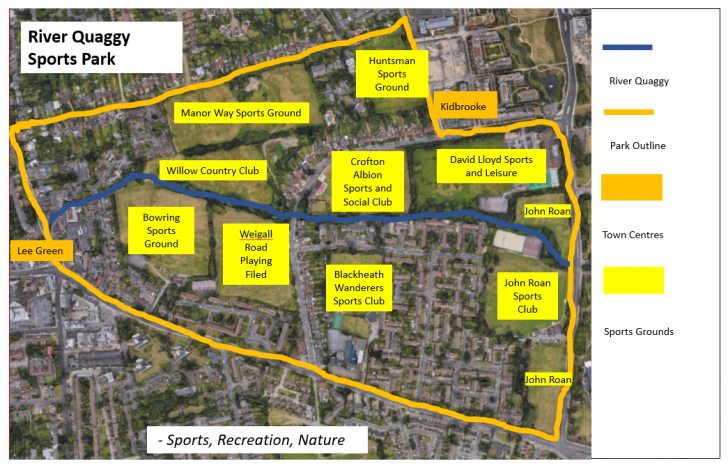
Today, whilst some fields are still available to the community, a large area of the fields have been closed, fenced off, overgrown and locked up. Clubhouses have burnt down or become derelict. Three fields have been subject to speculative planning applications.
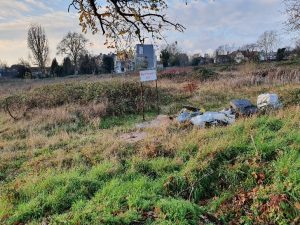
To the north of the river, two fields were bought several years ago. The new owners did not renew the sports club leases, made themselves uncontactable by new clubs wanting to lease them, and fenced the fields off, allowing them to deteriorate, knowing full well that after five years of disuse, Sport England is no longer able to appeal to the secretary of state undermining its ability to object to planning applications.
In the 20 years since the Huntsman site was targeted for development, it has turned from a thriving sports field to a disused, derelict one. Greenwich Council removed its MOL status. The High Court removed its protective covenant. It is now all but lost to development.
The Willow Country Club and Manor Way Sports Ground look now to be following the same trajectory: despite Greenwich noting in its Playing Pitch Strategy that it was ‘at risk of permanent loss of playing field land’, and despite an explicit aspiration to ‘protect and secure future use as playing fields with a capital budget of £455,000’ nothing has been done by the Borough to ensure the field is well used.
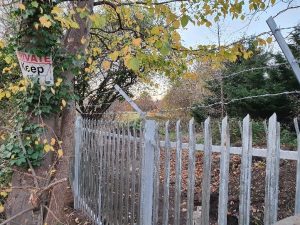
The Bowring Sports Ground was the subject of a speculative planning application in 2019. This was refused, but the importance of the site as a protected playing field was not the reason – rather simply that the proposed school was not needed in that location. It remains vulnerable to future speculative planning applications, as do the other fields.
In September 2022 we learned that the owner of one of the fields was looking to sell and buyers were approaching the active football club there, AFC Lewisham, talking about wanting to develop the site for housing, so the threat to these fields remains high, and clubs wishing to invest in the facilities continue to face challenges.
Locals remember when all the fields were well-used sports fields and they want to see them back in use. They point to the need for an over-arching plan for the area and say that with the new, high-density developments bringing a much bigger population, the playing fields will be much needed. They are only too aware that, the longer sites are fenced off with no public access, the more likely they are to be lost to development.
So they are now looking to create a new River Quaggy Sports Park, working with the Borough, owners and managers of all the adjacent sites to create a coherent park with a distinct identity where members of the communities at Lee, Kidbrooke and beyond can enjoy the benefits of well managed sports fields and more generally as an open access site for recreation, walking, leisure and nature.
There is already a separate but related project underway to open up a trail along the Quaggy River which would allow the communities of Kidbrooke and Lee Green to actively travel and celebrate and promote the River Quaggy, avoiding busy and polluted roads. Lee Forum has recently commissioned a feasibility study for this trail, with funding from Greenwich Council.
2. Banbury Reservoir Park
Near to the vast new Meridian Water housing development in Enfield, there is a patchwork of protected and other green spaces to the west, north and east of the Banbury Reservoir. These have been degraded as a result of fly-tipping, gravel extraction and road building and widening.
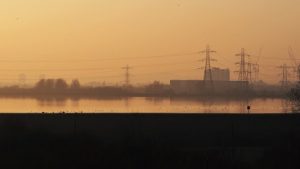
In Enfield Borough’s masterplan for the development, various proposals have been put forward for a new park to sit next to the high-density housing. However, local residents are very concerned that, with a much higher population, there will not be enough provision of green space and playing fields for this area, which already lacks enough green space facilities for the existing population.
The local standard for public park provision is 2.37 hectares per 1,000 residents. But Upper Edmonton already has a major deficit – with just 0.28 hectares per 1,000 – a deficit the size of 60 football pitches. With the population of Upper Edmonton set to almost double over the next 20 years, if no effort is made to provide more useful green space, a space the size of a staggering 110 football pitches will be needed to close the deficit.
Local residents want to propose a vision for a new park which incorporates various pieces of land directly adjacent to the new development but also land to the north of the North Circular and fields surrounding the Banbury Reservoir, making better use of fields which have been left to become derelict and using Compulsory Purchase Orders for private land where necessary. New features and facilities could be as diverse as new playing fields, a BMX track, ball courts, a nature park and much more.
CPRE submitted ‘Banbury Reservoir Park – Principles And Proposals’ to Enfield Council in June 2021, and the document was also shared with Waltham Forest Council (the park includes land in both Waltham Forest and Enfield).
The aim is for the 13 plots of (largely underused) Green Belt land identified in the Proposal to come together to form a coherent new 60-hectare District Parkland in an area of London that has a serious and worsening deficiency of green and blue space.
Encouragingly, Waltham Forest has since included large areas of the proposed park in its draft Local Plan as part of its strategy for ‘Suitable Alternative Natural Greenspaces’. This is a very positive step towards seeing the vision for Banbury Reservoir Park become a reality in some form and it is great that Waltham Forest recognises the potential of the land to help local people.
Local residents have also submitted the other sites needed to complete the new park to Enfield Council and are hoping that Enfield will follow Waltham Forest’s lead and include these sites in its next Local Plan.
3. East London Waterworks Park
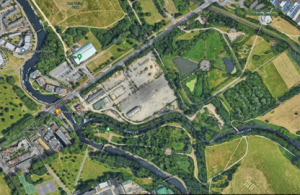
In the centre of the Lea Valley Regional Park and on the border of Hackney and Waltham Forest, this site is protected Metropolitan Open Land. Some time ago Thames Water was given permission to turn it into a depot and, more recently, it was sold on and a planning application to build two free schools was turned down. Now local people have set up a charity and are raising money to buy it and turn it into the East London Waterworks Park, a biodiverse, community-owned park that’s home to wild swimming ponds.
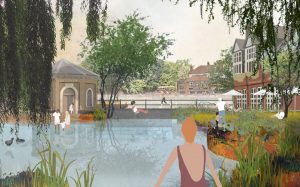
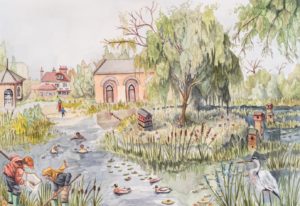
Imagine swimming all year round, in swimming ponds filled with rain water cleaned by reed beds and aquatic plants. Imagine meeting people and developing ideas in beautiful community spaces. Imagine being able to give different aspects of sustainable living a go. Imagine your children being able to attend a forest school, becoming resilient, independent and creative young people in amongst the trees and in the sunshine (and the rain). And imagine doing all of this for free or for a donation if you can afford it. This is the vision.
Sustainability, decarbonisation and enhancing the natural environment are central to East London Waterworks Park. Bringing back open water and returning the site to nature will do wonders for biodiversity (creating new habitats for wildlife) and air quality (with more trees to clean the air). The site will also operate as a circular economy (reducing waste by reusing, repairing and recycling materials) and generate its own renewable energy (generating solar power from solar panels and hydropower from the river). Cold-water swimming is also fantastic for physical and mental health, and providing free access will help tackle social inequalities.
Find out more including how to donate to help East London Waterworks Park buy the land.
4. Beddington Farmlands Nature Reserve
Beddington Farmlands is a 161 hectare site (slightly bigger than Hyde Park) at the centre of the wider Wandle Valley Regional Park. Together with the adjacent green spaces of Beddington Park and Mitcham Common, this is one of the largest contiguous green spaces in south London.
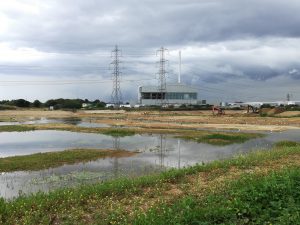
The site is an important area for wildlife, is classified as a Site of Importance for Nature Conservation and protected Metropolitan Open Land and it was once a jewel in London’s ecological crown. But its wildlife is now in shocking decline and promised management plans continue to be delayed. The site has benefited from over thirty years of citizen science recording what is happening to its wildlife. The last Breeding Birds survey showed eight species now extinct, failed or in drastic decline. The lapwings at Beddington Farmlands are now threatened with imminent local extinction. The iconic tree sparrow has collapsed from a thousand birds to a single breeding pair in just a decade. The citizen science effort has been curtailed by restrictions on access with a much more limited report provided by professional ecologists.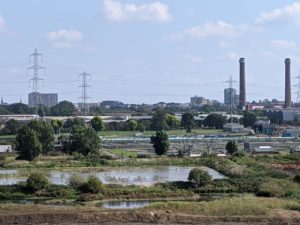
After much local campaigning there is the prospect of some limited public access which will start to allow people to enjoy this vast area of open space at the heart of the Wandle Valley Regional Park. A warden has also been appointed.
The site is now the location of an incinerator run by Viridor which was given planning permission by Sutton Council in 2013 on condition that a comprehensive management plan was drawn up to deliver an abundant, flagship nature reserve for local people and wildlife. This included requirements to restore the surrounding area, set targets for increasing key wildlife and restore the site into a mosaic of important habitats for wildlife. The site has been sold on to Valencia Waste Management.
Today the incinerator is finished but the restoration plans have fallen way behind.
Residents are campaigning for the Beddington Farmlands Nature Reserve to become a reality. They want Sutton Council, Viridor, Valencia Waste Management and Thames Water to put an end to the delays and work together to restore the site, deliver the promised nature reserve and manage the land competently to ensure the survival of the lapwing as well as other bird species and other wildlife reliant on the habitat.
Find out more: visit the Beddington Farmlands Nature Reserve website, the Wandle Valley Forum website, and read the original petition and the more recent petition.
5. Gorne Wood, Brockley
The Fourth Reserve Foundation is raising funds to save the closest site of designated Ancient Woodland to the City of London. (Also read: our September 2022 interview with local campaigner Anna-Maria about her work to save Gorne Wood and the vision they have for the site.)
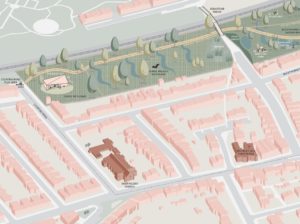
Gorne Wood in Brockley, Lewisham SE London is an extremely rare living remnant of the Great North Wood and a designated site of Ancient Woodland where 400-year-old trees, protected and endangered species, including hedgehogs and toads and ancient hedgerows can still be found, tucked between houses and a railway line.
Exactly a hundred years ago, a section of the land was leased to local people and named the ‘Dandy Fifth Park’ as a thank-you to the Brockley ‘Dandy’ Fifth Scout Troop for patrolling local railway bridges during the First World War. But in recent years the woods were sold into private ownership, local people were shut out, and the site is now being damaged and degraded. There is a risk it will be lost forever.
The Fourth Reserve Foundation has been successfully running a nature reserve adjacent to Gorne Wood and along the same railway embankment since January 2018. This nature reserve serves the local community including 12 Lewisham schools and provides a sanctuary space for female refugees. It has been supported by funders such as the National Lottery, the Feminist Review Trust, Stanley Smith Horticultural Trust, Groundwork UK and the Co op Local Community Fund.
They have created a vision for the Gorne Wood site with objectives to re-wild the community section of the woodland facilitating outdoor education opportunities; manage the oldest section of the woodland in accordance with the guidance for Ancient Woodland management, as a quiet space to preserve ancient features of the landscape; and connect Gorne Wood to the current managed nature reserve via a heritage ‘Brockley Green Walk’ experience.
The Fourth Reserve Foundation (registered charity:1186942) is raising funds to save the closest site of designated Ancient Woodland to the City of London. Find out more about the local campaign here.
6. Warren Farm Nature Reserve
Warren Farm in Ealing is a 61 acres site, roughly the size of St James’s Park, and is protected Metropolitan Open Land. It is part of the Brent River Park. The majority of the site was community playing fields but these have not been maintained since 2013.
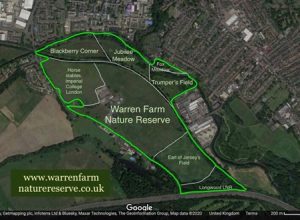
The community has continued to make good use of the fields and the site was slowly reclaimed by nature, rewilding to form a unique neutral and acid grassland habitat. Species of birds, mammals, plants, reptiles, amphibians and insects both common and rare in London, have been recorded thriving on the land.

The fate of the site has been precarious even though over a decade ago the council voted to give the site Local Nature Reserve status. More recently a decision was taken to lease the site to QPR Football Club to build training facility. This was abandoned in 2020 under pressure from conservationists and the Warren Farm Nature Reserve group was formed.
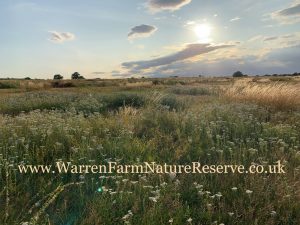
A plan to designate Warren Farm, and neighbouring meadows along the River Brent, as a statutory Local Nature Reserve has been put forward by the Brent River & Canal Society which campaigned successfully to create the Brent River Park in the 1970s. This proposal would preserve the meadows for future generations and ensure the protection of its rare and endangered species such as the skylark, a Red-Listed bird facing UK extinction.
The campaign to designate the meadows as a Local Nature Reserve has already gained some prominent backers, such as Lord Randall of Uxbridge, forensic botanist Mark A Spencer, young conservationist Kabir Kaul, the Barn Owl Trust, West London Ramblers and London National Park City and a local petition has attracted over 12,800 signatures.
In 2022 Ealing Council agreed to designate four out of the seven meadows as Local Nature Reserves. That leaves three meadows, including the main site Warren Farm which is Metropolitan Open Land and is owned by the council and two privately owned meadows either side of it. Discussions with both private landowners are ongoing and one has agreed in principle to Local Nature Reserve designation.
In April 2022 Ealing Council Leader, Peter Mason committed to ‘rewild the overwhelming majority of Warren Farm’. In May 2022 a Public Consultation revealed an overwhelming majority of respondents wanting Warren Farm protected for its biodiversity and safeguarded as a Local Nature Reserve.
However, despite this fantastic result for nature, Ealing Council still appears intent on creating sporting facilities. Southall Football Club has shown an interest in the land but as per the results of the Public Consultation in which 89 supported the club versus over 1000 wanting the site for wildlife with LNR designation, the question now is, will the results of the consultation carry enough weight? In August 2022 a request from the Warren Farm Nature Reserve group to remove Warren Farm from the Council’s sports strategy was rejected. Discussions with Ealing Council continue.
Find out more about the Warren Farm Nature Reserve, their petition and follow #WarrenFarmNR @WarrenFarmNR.
7. The Railway Children Park
The Grove Park neighbourhood’s biggest community and heritage asset is a stretch of Metropolitan Open Land running parallel to a railway cutting which inspired Edith Nesbit, who overlooked the cutting from the house she once resided, to write her now famous book The Railway Children. The cutting is also a Site of Importance for Nature Conservation with a range of priority habitats that include a wet woodland and chalk grassland, which, if all managed appropriately would create and even richer haven for wildlife. Sitting in the middle is the statutory Local Nature Reserve of Grove Park.
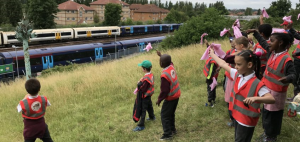
Local residents have campaigned tirelessly since the first public inquiry 1976 to save this relic countryside from development. The inspector ruled then that it should remain open space with ‘possibility of creating a district park in the Metropolitan Open Land’. The area is deficient in district level parks and so this remains a valid proposition 40+ years later. It will serve the existing and new residents as a result of development being planned in the Grove Park town centre, which is designated a ‘strategic area of regeneration’ in the new London Plan and Lewisham Council’s emerging new Local Plan.
However, in recent years more speculative developers have bought parts of the cutting and its destruction is being accelerated. Some parcels have now been fenced off, the equestrian centre forced to close and serious damage to habitats has been caused by the owner in the hope of gaining planning permission to build.
Local campaigners envision the creation of a new district park – the Railway Children Park – making the whole site accessible again, extending the nature reserve, bringing about the ecological restoration of crucial wildlife habitats as part of the wider nature recovery networks, and creating features and attractions to benefit the whole community.
Before and after images show recent destruction.
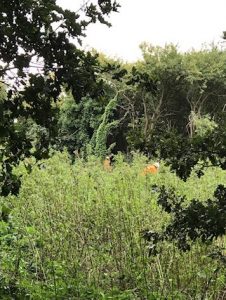
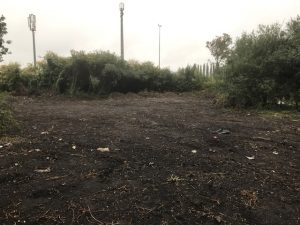
Work has progressed this summer on the masterplan design and feasibility for the proposed new district park in the Grove Park, SE12 area of Lewisham. The project seeks to bring forward the Grove Park Neighbourhood Plan vision that re-imagines the green corridor landscape, which runs along the railway cutting, into the Railway Children Urban National Park. If realised, it will enable a continuous nature and geo-trail from the South Circular all the way to the ancient woodland of Marvel’s and Elmstead Woods.
The project was awarded a £40,000 development grant from the Mayor of London’s Green and Resilient Spaces Fund earlier this year to further develop the district park vision – a vision is now firmly established in the Mayor of Lewisham’s manifesto. With some match funding from Lewisham Council’s NCIL fund, the project aims to bring existing Metropolitan Open Land and a SINC (Site of Importance for Nature Conservation) into more active use as well as ensure greater enhancement and protection of its nature conservation value.
8. ‘Edgelands’ – the new River Roding Park
This site is a series of connected green spaces next to the River Roding at the apex of three London Boroughs: Barking & Dagenham, Newham and Redbridge. Two large areas of green space appear to have been bought by developers and fenced off with a view to their being developed for profit.
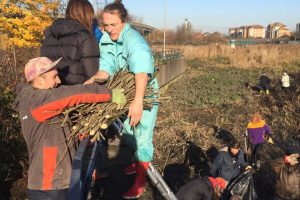
It is an ethnically diverse area with high levels of deprivation, poor access to green space and communities severed by roads and railway lines.
Much of the land is protected Metropolitan Open Land and also a rich habitat for wildlife.
The Roding River Trust would like to work with the local community to create a vision for a new River Roding Park which would include:
1. The River Roding Path: creating the missing link of the riverside walkway between Barking & Ilford and linking it in to the existing path at Wanstead Park by way of the Aldersbrook, and creating a new public linear park and wetlands on land currently owned by Transport for London.
2. The East Ham Levels Park – a new public park on the three playing fields on the West side of the North Circular, also linking them into the Roding and the Roding Path. Depending on discussions with the community, this could provide much needed sports or play facilities.
3. The Ilford Wetlands: opening up public access along the River Roding through the existing golf course area.
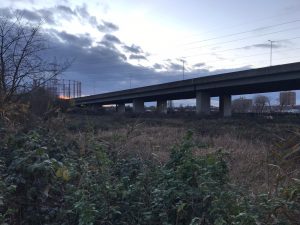
There are owls nearby as well as bats, egrets, grass snakes, sand martins and kingfishers, and a variety of tits and birds of prey the length the River to admire. The Trust monitors the local wildlife most of which is protected under law. Within the actual waters you can see Chub, Carp, Roach, Gudgeon and Barbel in the upper stretches, and Dace, Pike, Rudd, Perch and shoals of Minnows and Eels. The Trust is also looking into removing barriers in the river which impede their travel.
The River Roding Trust.
9. A Vision for Crayford Marshes
In 2023 we were contacted by a local group in Bexley concerned that their local green space had been bought by developers. We were astonished to find the site is not only Green Belt but a flood plain adjacent to the River Thames and an incredibly important site for wildlife. So we invited them to join our Ten New Parks for London campaign, which they did in March 2023.
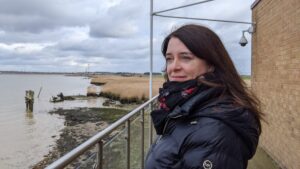
The Friends of Crayford Marshes are campaigning to save this much loved site located in Green Belt on the Thames at the outer edge of South East London. The site is protected Green Belt and a nature reserve with considerable historic interest but is now under threat from being built over having been bought by developers.
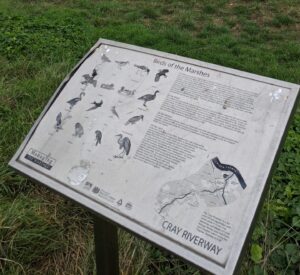
The local community values this site immensely, the last of the truly wild, natural spaces left in Bexley, with its large open green space and big skies. They use this unique green space for a range of activities, including organised wildlife walks, photography, cycling, sailing and general exercise. The London Loop and Thames Path walks go through it as does National Cycle Route 1.
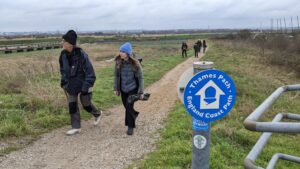
After a successful campaign in 2019, Crayford Marshes was saved from development, when a planning application for a large rail freight interchange was refused. The Secretary of State agreed with the Planning Inspector stating it would cause substantial harm to the Green Belt.
But only days later the whole site was purchased by Berkeley Homes.
The Friends are determined to protect this much loved wildlife haven with its many public footpaths through and around the marshes. Red-listed Skylark and Corn Bunting live and breed there and their home needs protection.
They are working with the RSPB, London Wildlife Trust, CPRE London, CPRE Kent and WWT to create ‘A Vision for Crayford Marshes’ and then want to campaign to make it happen. The vision will be a great way to show clearly to everyone the value of the site to people and wildlife and ultimately to save it as a critical site for nature conservation, and for the health and enjoyment of Bexley residents for generations to come.
You can follow the latest news about Crayford Marshes on Facebook and Twitter.
10. A vision for Hatton Fields
Hatton Fields is one of many Green Belt sites which Hounslow Council wants to allocate for development, in the case of Hatton Fields they want to turn it into a commercial business park connected to Heathrow Airport. CPRE London has been working with local campaigners to campaign to save these areas of Green Belt, pointing to the many brownfield sites available, in particular the very large areas of surface car park surrounding the airport which would be much more appropriate for this use.
One of the groups we have been working with are a local resident group linked to Hatton Fields – they are in fact the Friends of Hatton Fields, who have come together to defend this nature-rich green space which is also an important defence against climate change, absorbing rainwater and moderating high temperatures, which are particularly acute in this area because of the airport, which creates an ‘urban heat island’ effect.
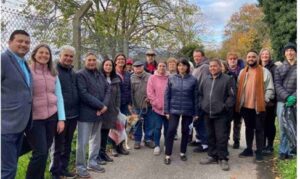
Clare Obeng of the Friends of Hatton Fields, a 107-acre biodiverse green space with Green Belt protection, said: “At the moment this green space separates our family friendly, community-minded village from one of the busiest airports in the world. If this development goes ahead, it will be like living inside the airport. We can do better for the West of the borough than losing this highly valued community green space. We want the entire site to be given a clear identity as a nature reserve, we want to restore an ancient orchard, open up community access to the Duke of Northumberland River and create a small-scale community garden.”
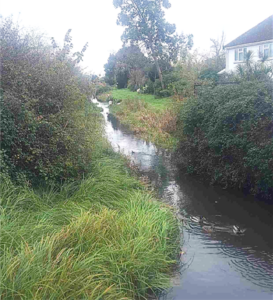
The campaginers have set out a vision for the site, set out below, along with a ‘road map’ showing what they feel needs to happen to realise the vision.
The Vision: in essence what the campaigners want is to see a continuation of mixed-use.
- Keep the sports clubs both in existence and see Bedfont FC able to thrive
- Keep all the football fields currently in place
- Keep horse fields and stables but our long-term vision is that there are more community links and potentially connect the schools (incl SEN school Marjory Kinnon) with the horse owners
- Make the wild meadows a nature reserve
- Install a community garden next to Flight Stables who already provide free manure and link to Hatton allotments to support each other with food security initiatives for the community
- Restore the ancient pear / plum orchard at the back of Bedfont FC
- Enhance pathways along south boundary and consider low-impact clearance so the community can access Duke of Northumberland River
- Install some signs and waste bins / dog waste bins
- Carry out volunteer days to maintain the fields and bring in Heathrow Giving Back and/or Countryside rangers to help. We want to keep the wild areas wild but we could enhance the habitat by infilling damaged hedges, installing bat boxes (we already have bats) and bird boxes
These initiatives would see community connections among many entities that border the fields.
The Roadmap – what needs to happen to realise the vision
- We need council to give permission for enhancements and unless the Friends of Hatton Fields can raise significant funding we would need the council to spend some money
- We need the council to agree to designate the site as a nature reserve (it’s already a SINC and Site of Borough Importance bordered by the Duke of Northumberland River which is a site of Metropolitan Importance)
- Carry out an ecology survey to assess current wildlife use and existence
- We would need funding to install a community garden and many of the other elements
- We would need Bedfont FC and Hounslow Council to finalise their ongoing lease negotiations so the club has more than a 10 year lease
- We would need to know the long-term position of the private owner of some of the land and to be able to work with them on some of the enhancement ideas
- We would need to have Hatton Fields removed from the West of Borough plan and/or a Council that is willing to see investment on the site in the interim
Read also the more detailed Vision for Hatton Fields.
www.friendsofhattonfields.co.uk, friendsofhattonfields@gmail.com, @HattonFields (twitter), Friends_of_hatton_fields (Instagram)
…………………………………………………………………………………
Let us know about neglected or threatened green spaces in London – and we can help you set up a local campaign to make sure it’s doing more for people and nature.
To support our Ten New Parks for London campaign donate here CPRE London fundraising & online donations | KindLink
…………………………………………..
Previously part of our Ten New Parks Campaign
The Welsh Harp (Brent Reservoir) Park
Part bird sanctuary and part recreational space, this site is 170 hectares of open water, marshes, woodland and grasslands, and a 70 year-old Site of Special Scientific Interest (SSSI) and Local Nature Reserve. Responsibility for the site is split between landowners (the reservoir and shoreline is owned by Canal and River Trust, the open areas by Barnet and Brent Councils) and managers (the Environment Agency manages the two inflowing rivers and the flood control function; Natural England advises on environmental issues and adjudicates on SSSI status).
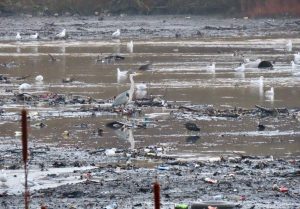
But the site has suffered decades of neglect and, in January 2021, when water levels dropped for dam repairs, it exposed an environmental crisis: vast amounts of rubbish, plastic and other pollution, as well as an excess of alluvium soaked in heavy metals, oils, nutrient pollutants and urban runoff. Unchecked fly-tipping and a lack of biodiversity plan has also held back the potential of the woodlands and open spaces.
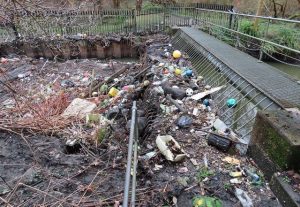
At this point, local campaigners formed an alliance to push for change. In response, in March 2021, Barnet and Brent Councils jointly announced they are “determined to secure a cleaner, greener future for Welsh Harp” and committed to a “long-term vision” to be outlined in a new upcoming management plan. It followed Canal and River Trust’s recent Action Plan for Brent Reservoir.
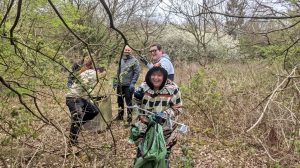
So all three land owners have now pledged to work together on the new visioning document and this could be a turning point for this famous but long-overlooked green space. With all the land owners now awake to the need for change, local campaigners have set out a 15-point Vision for Welsh Harp in an effort to kickstart a new era of environmental action at this historic SSSI. The goal is to reverse the decades of neglect and bring real change. They want the fifteen aims, covering the reservoir, shoreline and open space, to be included in any future official plan.
Read the Vision for Welsh Harp by allied campaigners
Follow the Friends of the Welsh Harp and join litter-picks
